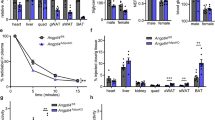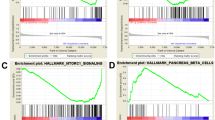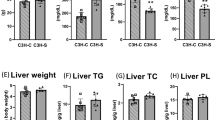Abstract
Background/objectives:
Elevated triglycerides predict insulin resistance and vascular disease in obesity, but how the inert triglyceride molecule is related to development of metabolic disease is unknown. To pursue novel potential mediators of triglyceride-associated metabolic disease, we used a forward genetics approach involving inbred mice and translated our findings to human subjects.
Subjects/methods:
Hemopexin (HPX) was identified as a differentially expressed gene within a quantitative trait locus associated with serum triglycerides in an F16 advanced intercross between the LG/J and SM/J strains of mice. Hpx expression was evaluated in both the reproductive fat pads and livers of mice representing three strains, LG/J (n=25), SM/J (n=27) and C57Bl/6J (n=19), on high- and low-fat diets. The effect of altered Hpx expression on adipogenesis was studied in 3T3-L1 cells. Circulating HPX protein along with HPX expression were characterized in subcutaneous white adipose tissue samples obtained from a cohort of metabolically abnormal (n=18) and of metabolically normal (n=24) obese human subjects. We further examined the relationship between HPX and triglycerides in human atherosclerotic plaques (n=18).
Results:
HPX expression in mouse adipose tissue, but not in liver, was regulated by dietary fat regardless of genetic background. HPX increased in concert with adipogenesis in 3T3-L1 cells, and disruption of its expression impaired adipocyte differentiation. RNAseq data from the adipose tissue of obese humans showed differential expression of HPX based on metabolic disease status (P<0.05), and circulating HPX levels were correlated with serum triglycerides in these subjects (r=0.33; P=0.03). HPX was also found in an unbiased proteomic screen of human atherosclerotic plaques and shown to display differential abundance based on the extent of disease and triglyceride content (P<0.05).
Conclusions:
Our findings suggest that HPX is associated with triglycerides and provide a framework for understanding mechanisms underlying lipid metabolism and metabolic disease.
This is a preview of subscription content, access via your institution
Access options
Subscribe to this journal
Receive 12 print issues and online access
$259.00 per year
only $21.58 per issue
Buy this article
- Purchase on Springer Link
- Instant access to full article PDF
Prices may be subject to local taxes which are calculated during checkout




Similar content being viewed by others
References
Mozaffarian D, Benjamin EJ, Go AS, Arnett DK, Blaha MJ, Cushman M et al. Heart disease and stroke statistics-2016 update: a report from the American Heart Association. Circulation 2016; 133: e38–e360.
Pi-Sunyer X, Blackburn G, Brancati FL, Bray GA, Bright R, Clark JM et al. Reduction in weight and cardiovascular disease risk factors in individuals with type 2 diabetes: one-year results of the look AHEAD trial. Diabetes Care 2007; 30: 1374–1383.
Freiberg JJ, Tybjaerg-Hansen A, Jensen JS, Nordestgaard BG . Nonfasting triglycerides and risk of ischemic stroke in the general population. JAMA 2008; 300: 2142–2152.
Nordestgaard BG, Benn M, Schnohr P, Tybjaerg-Hansen A . Nonfasting triglycerides and risk of myocardial infarction, ischemic heart disease, and death in men and women. JAMA 2007; 298: 299–308.
Paoli M, Anderson BF, Baker HM, Morgan WT, Smith A, Baker EN . Crystal structure of hemopexin reveals a novel high-affinity heme site formed between two beta-propeller domains. Nat Struct Biol 1999; 6: 926–931.
Stohs SJ, Bagchi D . Oxidative mechanisms in the toxicity of metal ions. Free Radic Biol Med 1995; 18: 321–336.
Tolosano E, Altruda F . Hemopexin: structure, function, and regulation. DNA Cell Biol 2002; 21: 297–306.
Morgan WT, Smith A. Binding and transport of iron-porphyrins by hemopexin. In: Sykes AG (ed). Advances in Inorganic Chemistry vol. 51. Academic Press: San Diego, CA, USA, 2001.
Lin T, Sammy F, Yang H, Thundivalappil S, Hellman J, Tracey KJ et al. Identification of hemopexin as an anti-inflammatory factor that inhibits synergy of hemoglobin with HMGB1 in sterile and infectious inflammation. J Immunol 2012; 189: 2017–2022.
Smith A, Morgan WT . Hemopexin-mediated heme uptake by liver. Characterization of the interaction of heme-hemopexin with isolated rabbit liver plasma membranes. J Biol Chem 1984; 259: 12049–12053.
Baumann H, Jahreis GP, Gaines KC . Synthesis and regulation of acute phase plasma proteins in primary cultures of mouse hepatocytes. J Cell Biol 1983; 97: 866–876.
Li RC, Saleem S, Zhen G, Cao W, Zhuang H, Lee J et al. Heme-hemopexin complex attenuates neuronal cell death and stroke damage. J Cereb Blood Flow Metab 2009; 29: 953–964.
Hunt RC, Hunt DM, Gaur N, Smith A . Hemopexin in the human retina: protection of the retina against heme-mediated toxicity. J Cell Physiol 1996; 168: 71–80.
Swerts JP, Soula C, Sagot Y, Guinaudy MJ, Guillemot JC, Ferrara P et al. Hemopexin is synthesized in peripheral nerves but not in central nervous system and accumulates after axotomy. J Biol Chem 1992; 267: 10596–10600.
Watanabe J, Grijalva V, Hama S, Barbour K, Berger FG, Navab M et al. Hemoglobin and its scavenger protein haptoglobin associate with apoA-1-containing particles and influence the inflammatory properties and function of high density lipoprotein. J Biol Chem 2009; 284: 18292–18301.
Fabbrini E, Yoshino J, Yoshino M, Magkos F, Tiemann Luecking C, Samovski D et al. Metabolically normal obese people are protected from adverse effects following weight gain. J Clin Invest 2015; 125: 787–795.
Robinson MD, McCarthy DJ, Smyth GK . edgeR: a Bioconductor package for differential expression analysis of digital gene expression data. Bioinformatics 2010; 26: 139–140.
Lawson HA, Zelle KM, Fawcett GL, Wang B, Pletscher LS, Maxwell TJ et al. Genetic, epigenetic, and gene-by-diet interaction effects underlie variation in serum lipids in a LG/JxSM/J murine model. J Lipid Res 2010; 51: 2976–2984.
Lawson HA, Cady JE, Partridge C, Wolf JB, Semenkovich CF, Cheverud JM . Genetic effects at pleiotropic loci are context-dependent with consequences for the maintenance of genetic variation in populations. PLoS Genet 2011; 7: e1002256.
Partridge CG, Fawcett GL, Wang B, Semenkovich CF, Cheverud JM . The effect of dietary fat intake on hepatic gene expression in LG/J AND SM/J mice. BMC Genomics 2014; 15: 99.
Chen X, Cushman SW, Pannell LK, Hess S . Quantitative proteomic analysis of the secretory proteins from rat adipose cells using a 2D liquid chromatography-MS/MS approach. J Proteome Res 2005; 4: 570–577.
Moreno-Navarrete JM, Ortega F, Moreno M, Ricart W, Fernandez-Real JM . Fine-tuned iron availability is essential to achieve optimal adipocyte differentiation and mitochondrial biogenesis. Diabetologia 2014; 57: 1957–1967.
Lawson HA. Animal models of metabolic syndrome. In: Conn M (ed). Animal Models for the Study of Human Disease. Elsevier: Cambridge, UK, 2013; pp 243–264.
Chen Z, Ichetovkin M, Kurtz M, Zycband E, Kawka D, Woods J et al. Cholesterol in human atherosclerotic plaque is a marker for underlying disease state and plaque vulnerability. Lipids Health Dis 2010; 9: 61.
Cohen E, Aviram M, Khatib S, Rabin A, Mannheim D, Karmeli R et al. Increased levels of human carotid lesion linoleic acid hydroperoxide in symptomatic and asymptomatic patients is inversely correlated with serum HDL and paraoxonase 1 activity. J Lipids 2012; 2012: 762560.
Mas S, Touboul D, Brunelle A, Aragoncillo P, Egido J, Laprevote O et al. Lipid cartography of atherosclerotic plaque by cluster-TOF-SIMS imaging. Analyst 2007; 132: 24–26.
McLaughlin T, Abbasi F, Cheal K, Chu J, Lamendola C, Reaven G . Use of metabolic markers to identify overweight individuals who are insulin resistant. Ann Intern Med 2003; 139: 802–809.
Nikolskiy I, Conrad DF, Chun S, Fay JC, Cheverud JM, Lawson HA . Using whole-genome sequences of the LG/J and SM/J inbred mouse strains to prioritize quantitative trait genes and nucleotides. BMC Genomics 2015; 16: 415.
Srivastava AK, Mohan S, Masinde GL, Yu H, Baylink DJ . Identification of quantitative trait loci that regulate obesity and serum lipid levels in MRL/MpJ x SJL/J inbred mice. J Lipid Res 2006; 47: 123–133.
Seidelmann SB, De Luca C, Leibel RL, Breslow JL, Tall AR, Welch CL . Quantitative trait locus mapping of genetic modifiers of metabolic syndrome and atherosclerosis in low-density lipoprotein receptor-deficient mice: identification of a locus for metabolic syndrome and increased atherosclerosis on chromosome 4. Arterioscler Thromb Vasc Biol 2005; 25: 204–210.
Gebre-Medhin M, Ewald U, Tuvemo T . Reduced serum proteins in diabetic children on a twice-daily insulin schedule. Acta Paediatr Scand 1985; 74: 961–965.
Gabrielsen JS, Gao Y, Simcox JA, Huang J, Thorup D, Jones D et al. Adipocyte iron regulates adiponectin and insulin sensitivity. J Clin Invest 2012; 122: 3529–3540.
Jeney V, Balla G, Balla J . Red blood cell, hemoglobin and heme in the progression of atherosclerosis. Front Physiol 2014; 5: 1–11.
Mehta NU, Grijalva V, Hama S, Wagner A, Navab M, Fogelman AM et al. Apolipoprotein E-/- mice lacking hemopexin develop increased atherosclerosis via mechanisms that include oxidatice stress and altered macrophage function. Arterioscler Thromb Vasc Biol 2016; 36: 1152–1163.
Acknowledgements
We thank Dr Irfan Lodhi for sharing his 3T3-L1 differentiation protocol and Dr Larry Spears for his assistance in trouble shooting the western blotting experiments. This work was supported by NIH-NIDDK K01 DK95003 and P30 DK56341 to HAL and in part by the EA annual grant contest (2012) co-sponsored by Illumina and Golden Helix to L-LG, SK and HAL. The content of this paper is solely the responsibility of the authors.
Author contributions
HAL designed the study, conducted experiments, analyzed data, wrote the manuscript and secured funding and collaborations. MZ performed the carotid endarterectomy operations, prepared the carotid artery plaque homogenates, conducted the pilot proteomics scan and assisted with manuscript preparation. JPW conducted experiments and assisted with manuscript preparation. EF collected and prepared MNO/MAO subject data. L-LG prepared the MNO/MAO RNA samples. SK provided MNO/MAO subject data and samples and assisted with manuscript preparation. CFS assisted in study design, contributed reagents, provided laboratory space and equipment for experiments and assisted in manuscript preparation.
Author information
Authors and Affiliations
Corresponding authors
Ethics declarations
Competing interests
The authors declare no conflict of interest.
Additional information
Supplementary Information accompanies this paper on International Journal of Obesity website
Supplementary information
Rights and permissions
About this article
Cite this article
Lawson, H., Zayed, M., Wayhart, J. et al. Physiologic and genetic evidence links hemopexin to triglycerides in mice and humans. Int J Obes 41, 631–638 (2017). https://doi.org/10.1038/ijo.2017.19
Received:
Revised:
Accepted:
Published:
Issue Date:
DOI: https://doi.org/10.1038/ijo.2017.19
This article is cited by
-
Differentially expressed serum proteins from obese Wistar rats as a risk factor for obesity-induced diseases
Scientific Reports (2020)
-
Dietary iron interacts with genetic background to influence glucose homeostasis
Nutrition & Metabolism (2019)



